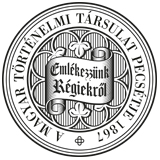Századok – 1995
Tanulmányok - Kristó Gyula: A honfoglaló magyarok életmódjáról I/3
A HONFOGLALÓ MAGYAROK ÉLETMÓDJÁRÓL 61 maisons construites de plâtras, ш(ше servants comme domiciles fixes. Cette population était autoentretenue. Le nomadisme subsistait exclusivement dans les milieux des gens qui pouvaient garder leur liberté personnelle et ne perdaient pas le cheptel. Pour le moment ils n'avaient pas été subordonnés, soit les archives commentant les affaires du régime fondai féodal ne les mentionnaient pas. Ce n'étaient que les lois des siècles ll-12èmee ou des sources narratives de ces siècles qui les faisaient figurer. Ces gens libres dans la majorité des cas de ces siècles continuaient le mode de vie de leurs ancêtres: changement des pâtures, élèver de cheval, vivre sous tente dont les conditions qui devenaient plus en plus défavorables pour eux. Parmi eux tôt au tard les plus pauvres jusqu'à la fin du 12e siècle sont devenus subordonnés, tandisque les plus riches passaient au nouvel ordre. Des premiers se formaient les serves de cheval — au sommet de la hiérarchie des serves — des derniers devenaient les serviants royaux qui faisaient dans le 13e siècle l'élite dirigeante. Le féodalisme hongrois imprégné par les couleurs barbares-nomades des ll-12e 8 siècles: à partir du début du 13e siècle commeniait vite s'assimiler aux conditions féodales de l'Europe de l'Ouest. La conclusion finale constate — sous la base de l'analyse — que les Hongrois conquérants n'étaient ni domiciliés, ni demi-nomades mais des nomades qui connaissaient déjà les éléments de l'agriculture, faisaient le grand élevage, une vie migrante, changement des pâtures. Cette thèse se confronte aux résultats de recherche hongroise actuelle des dernières décennies — aux résultats lesquels le premier chapitre analyse comme précédent de la recherche de cette question. Les analyses de source faites sur la base des documents exigent les confronter aux conclusions des autres disciplines. ON THE LIFE OF THE MAGYARS AROUND THE CONQUEST (Based on written sources) by Kristó Gyula /Summary/ The paper surveys and offers an explanation of those source materials from the tree centuries between the late 9th and the 12th centuries that prove the nomadic features of Hungarim life and economy. The nomadic way of life involves primarily stock-breeding but demands also a certain level of farming. It is not merely a manner of production but a complete way of life of a society, subordinating everything to itself. Stock-breeding, i.e. horse-breeding with the Hungarians, demanded a mobile way of life, for the animals had to be driven from pasture to pasture. A separate chapter is devoted to the sources mentioning the horses when speaking of the Magyars of the day. Changing pastures was made easier by the mobile homes of the Magyars. Another chapter is devoted to the sources mentioning the tents they lived in, and to the ones referring to wandering from pasture to pasture. There are also sources that characterize the Magyars as a nomadic people in the years 880-950. The social basis of the nomadic societies of the day were the freemen constituting the majority of the society, who possessed horses and weapons and took part in raids to the west. As soon as the nomadic society started to lose its social basis, it immediately started to decline. From the second half or the end of the 10th century, an ever increasing number of freemen became dependent on estates organized along new lines and values (belonging to chieftains, heads of clans, kings, churches and private landowners serving them). The organs of oppression started to work and the relatively needy of the freemen had to change their way of life soon. They were burdened so that they were unable to continue their former way of life. It is these elements we can mostly read about in the diplomas of the ll-12th centuries. This is why the diplomas reflecting the new order do not mention nomadism any more. The people they speak of mostly lived in villages with set boundaries and in permanent houses, however poor abodes they were, and were self-sufficient. Only those people were able to go on with their nomadic life who were still free personally and had not lost their stock. They were not subjugated for the time being and were, therefore, uninteresting for those who wrote the diplomas discussing the feudal system of ownership. They are mentioned only in the laws of the 11th century and in the narratived of the ll-12th centuries. They went on leading the life of their ancestors during most of this period: lived in tents, bred
